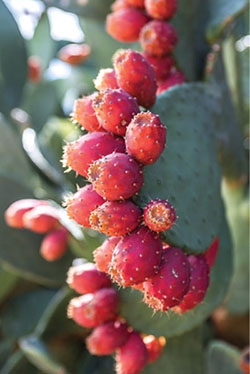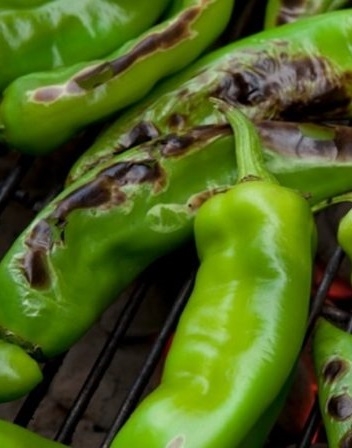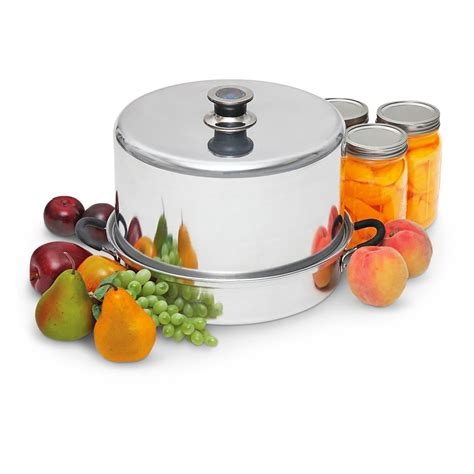- Author: L. Watts
I knew that atmospheric steam canners (AKA "ASC" from here on) were good to go with canning jams and jellies. But, on Reddit's Canning board, Steam Canning Question (8/16/2023) , I found welcome links to the NCHFP stance on ASCs: Burning Issue: Using Atmospheric Steam Canners, and these links from Wisconsin University about the same thing: Safe Preserving Using a Steam Canner and An Update On Safe Use Of Steam Canners.
Very nice--I can not only process jams and jellies in a steam canner safely, but I can process naturally high acid fruits and acidified products in a steam canner as well, following advice/instructions in the above articles.
Good to learn something new, everyday.
- Author: Lauria Watts
APPLE BUTTER
I finally made some more apple butter.
Friends down the street picked me two BIG bags full of Winter Banana apples. Some were sweet for eating, some were a bit on the tart side. All were pretty much free from bug damage. Fewer/no bugs is great news when you need to prep a bunch of apples.
Any way, the apples awaited processing in two big plastic grocery bags. Surprise, surprise, I got up the next morning, washed those apples, and strong-armed my daughter into coming out to help. Apples were cored, cut into chunks, plopped in lemon-water in my gigator stock pot. On to the stove they went to cook.
They softened up fine, so I ran them through a food mill. There were not many skins tough enough to survive the mill, so my yield of sauce to make butter with was high. Back in the pot to cook VERY slowly they went. As the weather was mild I was able to put them on our stove over a flame so low that they barely simmered. They cooked and cooked and cooked some more. Finally the reduced pulp was put into my heavy-duty blender to get an extremely smooth puree.
The puree was sweetened with some organic sugar I wanted to use up, with a bit of salt added for balance. Two tablespoons of Saigon Cinnamon and ½ teaspoon of cloves were added for a bit of spice. Back to the stove it went and cooked some more. When checked again, it was still a bit on the tart side, but much thicker. What sugar was left and perfection was achieved!
After filling and processing what butter was there in the pot, I had a little over two gallons of apple butter put away.
A couple of gallons of apple butter you ask? What do you do with that much apple butter? Well, I give it away for Christmas presents. I use it to sweeten pies and fill cakes. It can be made into BBQ sauce. can be used to sweeten drinks like coffee and tea for a fruity treat. What I am really looking forward to is having a peanut butter and apple butter sandwich. And apple butter on hot biscuits ain't too shabby either. Don't forget eating spoonfuls as candy! And you know what? I might just try to run some of this stuff run through the dehydrator; it would probably make some really great apple butter leather. And since I have lots of butter, I can use it to line french apple tarts too.
Apple butter can be made by cooking it faster. But, when cooking fast, the risk is run of burning the butter; burnt apple butter is not tasty at all. I've found that cooking too fast means there will almost always be at least a bit of molten butter splashed on my arms as it really starts to get thick. Apple butter blisters are no fun at all. It could also be cooked fast by constantly stirring small amounts in a broad, shallow pan, but the amount of active time for this was daunting for the gallons of apple butter I was making. Give me the slow cook, low active time any day.
Did all the time I spent cooking and stirring on and off pay off? Yes! I love this batch of apple butter. It's the best I ever made. That being said, my desire for apple butter will most likely be sated for the next couple of years!
NCHFP Apple Butter recipe: https://nchfp.uga.edu/how/can_02/apple_butter.html
NCHFP Reduced Sugar Apple Butter recipe: https://nchfp.uga.edu/how/can_02/apple_butter_reduced.html
- Author: Lauria Watts
What's Another Name For a Prickly Pear? (Hint: Sounds the same as a fish you may know and like)
As I drive around I check out stuff. New streets, new areas, places to shop, ideas for landscaping. Landscaping, hmmm. Cactus plants are pretty common. The big fleshy pads (nopal or nopalitos) are edible and just as tasty as green beans when properly prepared (or buy a bag from the produce section at your local Mexican or middle-American ethnic market).
At times I see the large egg-shaped fruit of the cactus (AKA prickly pears in English) in markets in big red, yellow or orange piles. These fruits, known in Spanish as “tunas” (singular “tuna”), are quite edible. Sweet, they are used to make jams, jellies, syrups and desserts and can be used to make brine to pickle other plant edibles. Oftentimes you will see prickly pear jelly in roadside stores in the southwest.
So you have some on your property? Your neighbor's property? There are some growing over someone's back fence? Pick your own or ask permission and pick someone else's. Most people are happy to let you pick, especially if you promise (and deliver!) results of your pickings from their plants.
You will want to avoid pricklies and thorns from the prickly pears. So arm yourself with a little knowledge for a special canning project. Make yourself some sweet treats and gifts from the cactus plant.
Here are some links to New Mexico State University sites for picking, processing and cooking or canning with tunas/prickly pear fruits. Remember, even though tart the prickly pears are a low acid fruit and the pads/nopals are as well:
https://aces.nmsu.edu/pubs/_e/E217/welcome.html Cactus Concoctions: How to Prepare and Use Prickly Pear Cactus Fruit and Pads. Here you will read a brief history of the cactus used for nopals and prickly pears/tunas. You will want to follow the instructions on how to pick and process prickly pears so to avoid the spines and glochids (mini-spines).
- Author: Lauria Watts
Canning Chiles—Can a Batch of Hatch?
I keep getting e-mails from a Chile grower/seller in New Mexico. They are selling the famous Hatch chiles. Hatch chiles are offered in hot, medium, or mild. Pre-roasted, you got it. Make a choice of chopped or whole; they are shipped to you frozen. Also offered up are fresh chiles, green or red chile powder, canned chile salsas, frozen chile rellenos, chile wreaths and ristras (long strings of dried chiles), freeze dried chiles, dried chile powder. . . well you get the picture, right?
Any way, if I ordered some Hatch, it would probably be fresh. I love the smell of roasting chiles; it's almost as if I were eating them. Of course it is tantalizing to order some already processed and frozen as the heat of this time of year I would be very reluctant to have to roast a bunch. In any case, the recipes at the links below can be used with mail ordered chile products, back yard chiles, store bought (try a Hispanic or Mexican market for a good selection), or from a farmer's market. With luck you might find some at a local super market because, after all, it is chile season.
Chiles are good and good for you. Whether you like them mild or mouth-burning hot, try preserving some to add more spice to your food and diet.
https://aces.nmsu.edu/pubs/_e/E326/welcome.html Home Canned Sweet Spreads Made with Green Chile. Some of these spreads look mighty inviting for a change of pace from regular ol' fruit jams and jellies.
https://aces.nmsu.edu/pubs/_e/E308/welcome.html Canning Green Chile. If you can your own green chile you will have ready-made deliciousness waiting in your pantry. You can add them to all sorts of stuff.
https://aces.nmsu.edu/pubs/_e/E323/ Salsa Recipes for Canning. There are a variety of salsa recipes here: thick and thin, green and red and a mango salsa thrown in for good measure.
https://aces.nmsu.edu/pubs/_e/E322/welcome.html Drying Chile Peppers (scroll down, look for “Chile Peppers, Green” and “Chile Peppers, Red”). You gotta have dried chiles and chile powder around, making enchilada sauce is really quite simple and quick using dried chiles or chile powder.
https://aces.nmsu.edu/pubs/_e/E327/welcome.html Using Chile to Make Ristras and Chile Sauce.
https://aces.nmsu.edu/pubs/_circulars/CR517/ New Mexico Favorites: Chile and Pecans; a bunch of recipes using chiles, pecans or both.
- Author: Darrell Fluman
- Editor: L. Watts
I say good for the young woman below! Thank you, Darrell, for passing the below to me to post here.
I wish I could taste it.
Having trouble with your Orange Marmalade?
Try harder.
This 9 y/o won Double Gold on her first try.
Deemed World's Best over 3000 other competitors.
https://www.cbc.ca/…/nine-year-old-girl-award-winning-marma…
Now featured @Fortnum &Mason. 5.95£ + 25£ delivery to North America. OUCH!
Sorry, but it is already out of stock.
This should be an inspiration for us all.
p.s. Secret ingredient Orange blossom water.




